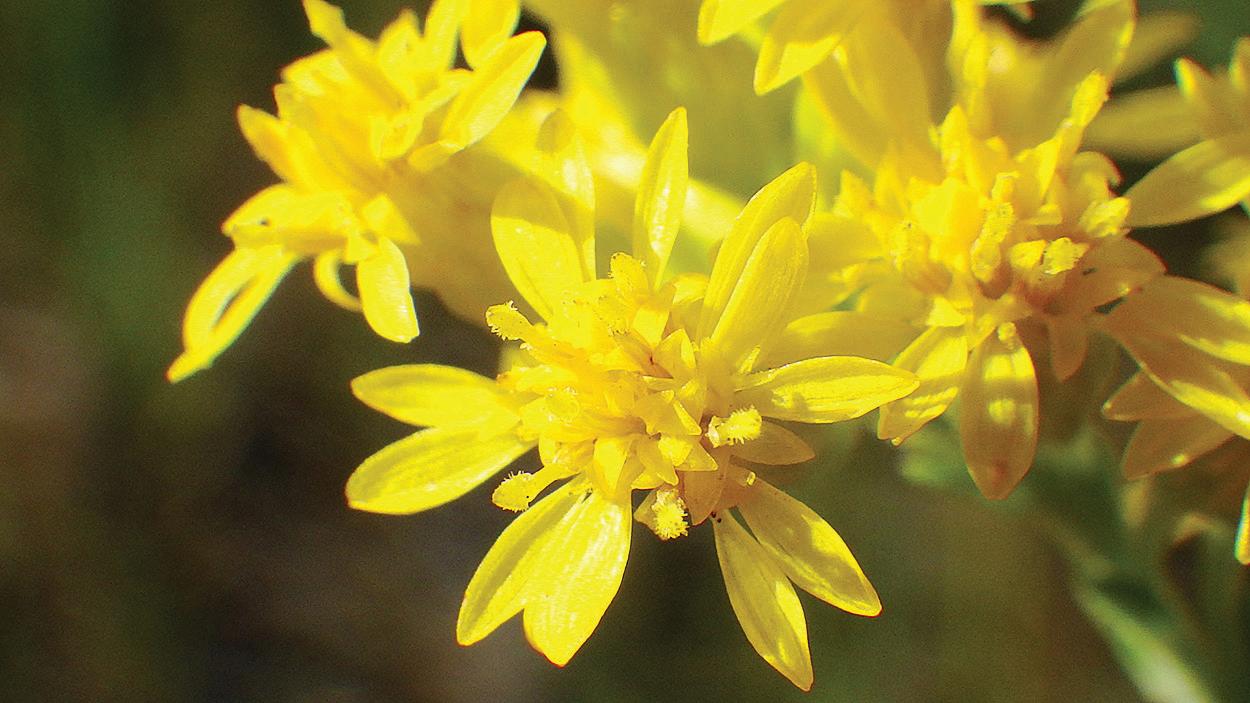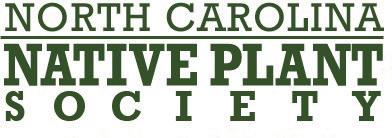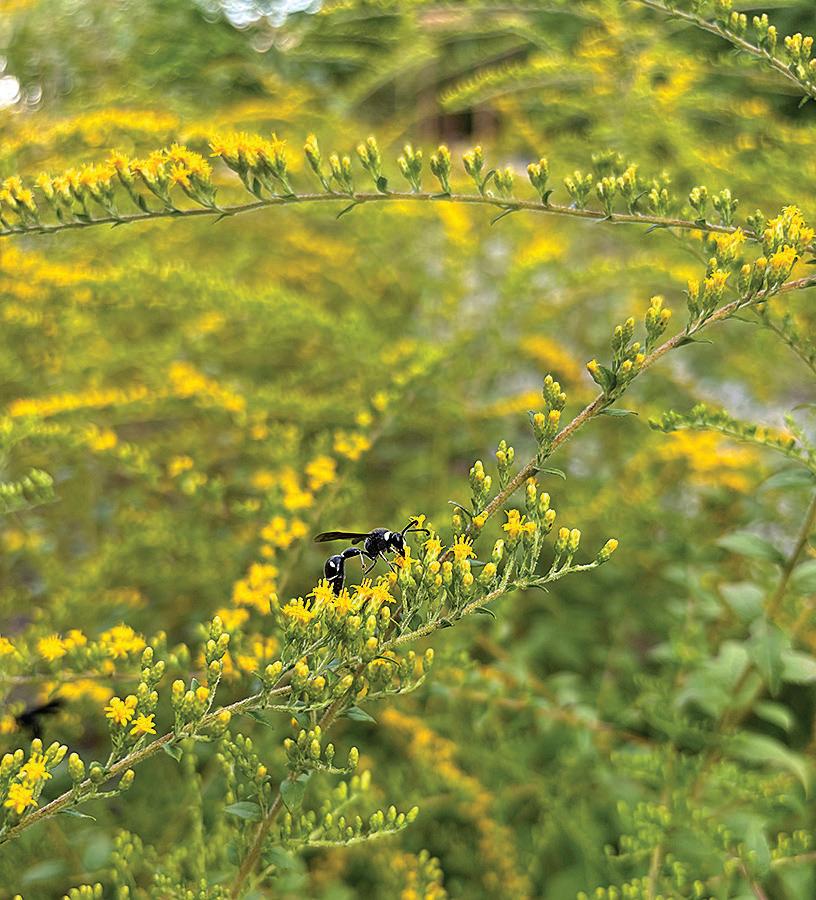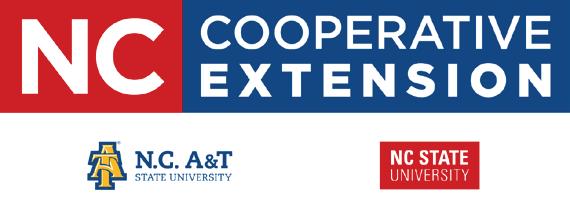




Welcome to the Ninth Annual Native Plant Festival!
We have re-imagined the 2024 festival as a free four-day event, to give everyone more time to attend the lectures of interest and explore more of the participating plant nurseries. This year, lectures will be offered at the New Hanover County Arboretum the evenings of September 18–20, the three days leading up to Saturday’s Festival Shopping Day on September 21.
Evening Speaker Series (at the Arboretum)
The speaker schedule appears on our back cover. Follow the links to the Festival web page to register in advance for speakers you’d like to hear. Seating is limited, so register early!
Plant Shopping Day (throughout the Community)
Saturday’s Shopping Day is again a self-guided tour of nurseries that specialize in native plants: you can buy directly from the growers and ask questions about how to care for plants once you get them home. Eleven different plant sellers are participating this year, at five locations in Brunswick, New Hanover and Pender Counties. See our map on pages 4–5 for locations. Plants will not be for sale at the Arboretum.
There will be no Festival activities at the Arboretum the Saturday of the Festival. Extension Master GardenerSM volunteers will be on hand at Pender Pines, Blooms + Branches, and Shelton Herb Farm to answer your gardening questions. The Garden Shop on Moss will host this year’s seed swap. Blooms + Branches will also feature 4-H children’s activities!
The mission of the Native Plant Festival is to educate the public on the benefits and importance of native plants for our local ecosystems, and to promote and support native plant growers to increase demand and supply of native plants in our region. By visiting various local sellers, you can get familiar with growers available to you not just the day of the Festival, but all throughout the year. We encourage you to continue to patronize local, independent growers of native plants.
We appreciate your interest and hope you enjoy the Festival.
— The Native Plant Alliance Festival Planning Committee
Native plants are a wonderful choice for the home gardener. Plants that have evolved in your home region are suited to thrive with minimal care once established. They have also co-evolved over time to be part of the whole ecological system of the area: beneficial insects live on native plants (and not non-natives), and in turn are available as food for birds rearing their young and other wildlife.
See page 7 for information on the Nature at Work program to support biodiversity by planting natives.
True native plants are those that are found in the wild in their original geographical areas and environments. Cultivars are plants that have been cross-bred either naturally without human intervention or those bred to have favorable traits, such as color, form, productiveness or hardiness. If the cultivars are used for decorative purposes, no harm done. If the cultivars are used for commercial or scientific purposes, it is important to preserve information about the plants used to create the cultivars. Whether you use true natives or cultivars, enjoy the plants and treat them well.
See article on page 3 for more about the two kinds of goldenrod featured on our cover.
Top photo: Prairie Goldenrod (Solidago nemoralis). Observation © Matthias Buck. inaturalist.org/observations/142728723. No changes made. Bottom photo: Wrinkleleaf Goldenrod (Solidago rugosa) Observation © Roger Debenham. inaturalist.org/observations/4135904. No changes made.
Cape Fear’s Going Green is a quarterly publication promoting eco-friendly resources and lifestyles in the Lower Cape Fear River Basin.
Publisher & Editor in Chief: Valerie Robertson
Sister City: Eugene, Oregon (Voted “Greenest City” 2006 by The Green Guide)
Eugene Contributing Editor: Mary Robertson
Advisors & Editorial Contributors: Caitlyn Andrews, Randy Bodkins, Matthias Buck, Roger Debenham, Shelby Diehl, Amy Mead and Karen Mulcahy.
Cape Fear’s Going Green
Going Green Publications
P. O. Box 3164 • Wilmington, NC 28406 (910) 547-4390 publisher@goinggreenpublications.com www.goinggreenpublications.com
Cape Fear’s Going Green is available by subscription or on our Web site.
Print copies are available at eco-friendly businesses and locations, including: New Hanover County Arboretum, Aunt Kerry’s Pet Stop, Lovey’s Market, New Hanover County Public Library branches, Old Books on Front Street, Pomegranate Books, Tidal Creek Co-op, UNCW, Shelton Herb Farm, and many Harris Teeter and Food Lion stores throughout the region.

Editorial: If you have story ideas or calendar items to suggest, email us at editor@goinggreenpublications.com, or call (910) 547-4390.
Advertising information: Email advertising@goinggreenpublications.com. Cape Fear’s Going Green is distributed free through Brunswick, Columbus, New Hanover, Onslow, and Pender counties. If you have a business and would like to receive multiple copies for the public, please contact us.
The views and opinions expressed in articles in this magazine are those of the authors and do not necessarily reflect the official position of this publication.
by Shelby Diehl
If you’re in the market for a beautiful perennial for your ornamental garden or wildflower meadow, look no further. Solidago, or Goldenrod, is an alluring flower that grows in dense clusters consisting of medium to dark green leaves and bright yellow petals. While we humans swoon over the golden color, bees, birds, and other pollinators adore the pollen produced by this flower—especially butterflies.
While primarily native to North America, select species are native to Central America, South America, the Caribbean, and Eurasia. Over 70 of these species can be found in North Carolina, though most grow in the mountains. Whether you’re looking for an endemic flower or a shade-tolerant plant, goldenrod has options for everyone. Let’s explore some options native to southeastern North Carolina.
If you’re looking for a versatile option, Solidago nemoralis is the goldenrod for you. This flower ranges from southern Canada to the Rockies to northern Mexico, adapting to each ecosystem with ease. This under-utilized species is shorter—up to three feet—and less aggressive than your standard goldenrod, making this perfect for a wildflower meadow and/or garden.
Individual plants bloom at various times, which means you’ll find the typical flowering season to range from June to October. But no matter the season, if you want Solidago nemoralis to thrive, you’ll want to plant the flower in dry soil whether that be sandy, loam, or clay. You don’t have to worry about light when it comes to this flower, as it can survive in sun, partial shade, and shade.
Glandular wand goldenrod is exclusive to southeastern North Carolina, occurring in Brunswick, Craven, Dare, New Hanover, Pender, and Onslow counties. This endemic perennial faces many threats like climate change and habitat destruction and degradation, so if you’re looking to help a dwindling population, Solidago villosicarpa may be for you.
These flowers grow up to five feet tall and prefer dry to wet soils that range from excessively drained to well-drained. In the wild, glandular wand goldenrod flowers prolifically after a pre -
Goldenrod gets the blame for your itchy eyes and runny nose, but the culprit is actually ragweed. Both plants bloom at the same time. Goldenrod flowers contain nectar to attract pollinating insects, and the large, heavy pollen grains attach to the insect bodies. Ragweed flowers do not contain nectar, and the plants are dependent on the wind to transfer the small, lightweight pollen. This pollen has the ability to blow for miles. A single ragweed plant can produce over a billion pollen grains. The next time you think it’s the beautiful goldenrod causing your allergy woes, think again. Source: hgic.clemson.edu

scribed burn, but don’t fret. You’ll find yourself having beautiful golden blossoms without needing to light a torch. Be sure to plant these flowers where they can get plenty of sun if you want to see those stunning petals.
The bluestem goldenrod isn’t as sparse as the former, ranging from coastal North Carolina to the rocky mountains. This perennial thrives in late summer, with slender stems and yellow flowers growing up to three feet tall. Solidago caesia is a hit with butterflies and birds, making you popular with local wildlife, but only if you take proper care of it. To help this goldenrod thrive, plant the flower in a sunny or a partially-shaded location with dry soil.
Unlike other goldenrods, bluestem goldenrod isn’t very aggressive, so you can count on this plant to keep to its section of the garden. One of the best parts of this flower? Like other goldenrods, Solidago caesia do not have wind-borne pollen. The plant relies on pollinators to spread pollen, so you don’t have to worry about getting hay fever if you plant goldenrod!

made.
(continued on page 6)


Paul Hosier will lead a plant walk on Lea-Hutaff Island sometime late in September. The group asks that all participants be fully vaccinated. Contact Charley Winterbauer at cewinterbauer39@gmail.com for details and to sign up for the walk.

Wrinkleleaf Goldenrod (Solidago rugosa) Observation © Roger Debenham. inaturalist.org/observations/4135904. No changes made.
Solidago rugosa’s narrow, toothed, and rough-surfaced leaves have earned it many names, ranging from Wrinkleleaf Goldenrod to Rough-leaved Goldenrod to Rough-stemmed Goldenrod. No matter what you call it, the rugged leaves complement the tall, rough, hairy stems that bear the golden blossoms. This perennial is highly variable, growing in clusters up to
six feet tall. In fact, this species is divided into two subspecies, with the most common subspecies subdivided into three varieties.
Cape Fear Audubon hosts monthly programs of interest to birders. Autumn Programs on Zoom - Links to these programs will be sent out by email to members and by posts on the Cape Fear Audubon Facebook page. All programs begin at 7:00 p.m.
September 15
For this species, you’ll want wet, welldrained soils and a sunny location. Similar to other goldenrods, Solidago rugosa blossoms in late summer. If you want these yellow flowers long into fall, wrinkleleaf goldenrod lasts until November—compared to the typical October. These conspicuous flowers will pair beautifully with your fall decorations and the first colors of autumn, so long as you tend to it.
October 6
explorer.natureserve.org/Taxon/ ELEMENT_GLOBAL.2.148511/ Solidago_villosicarpa wildflower.org prairienursery.com/blue-stemmed-goldenrod-solidago-caesia.html
Shelby Diehl is the Southeast Forestry Communications Specialist at the National Wildlife Federation and a Contributing Editor for Going Green.
• Want to learn more about native plants?
• Go on plant walks with knowledgable experts?
Paul Hosier will lead a NC Native Plant Society walk to Lea-Hutaff Island.
• Meet folks who share your interest?
“Our mission is to promote the enjoyment and conservation of North Carolina’s native plants and their habitats through education, protection, cultivation, and advocacy.”
After over a year of staying isolated we are happy to get back to doing plant walks. We look forward to going to new places and are open to your suggestions.
The North Carolina Native Plant Society offers plant walks, workshops and other plant-related activities. To receive the schedule of events, go to www.ncwildflower.org to join the state-wide NC Native Plant Society. Based on your address, you will automatically be assigned to a local chapter. Those in the SE portion of the state automatically become members of the SE Coastal Area Chapter.
If you would like to be informed on the walk schedule and other plant-related activities, go to www.ncwildflower.org and join the state-wide NC Native Plant Society. Based on your address, you will automatically be assigned to a local chapter. For the SE portion of the state, that is the SE coastal area chapter.

Questions? Email

Visit ncwildflower.org/se-coast for photos of recent activities. Questions? Email cewinterbauer39@gmail.com.

Meteorologist Tim Armstrong of Wilmington’s office of the National Weather Service has a really cool program on bird migration and radar. We’re calling it Tim will discuss BirdCast, a program of the Cornell Lab of Ornithology and the U.S. Fish and Wildlife Service, that has been coordinating data and images from more than 120 radar stations across the country. It tracks migrating birds and helps create data for phenomena when birds and weather collide—such as when seafaring birds become trapped within a hurricane’s eye, sometimes depositing them miles away.
Potter wasps (Eumenes graternus) such as this one spotted at the Brunswick County Botanical Garden are especially fond of Solidago. You may have seen them making little round nests in the eaves of a house. The goldenrod pictured here is Solidago rugosa ‘Fireworks,’ a popular cultivar of Solidago rugosa. Due to its popularity, it is sometimes easier to find from local retailers than other kinds of goldenrod. See page 2 for a mention of natives and the cultivars bred from them.
Dr. Christopher Tonra, Associate Professor of Avian Wildlife Ecology at Ohio State will introduce us to MOTUS, an international collaborative research network that uses coordinated automated radio telemetry to facilitate research and education on the ecology and conservation of migratory animals. Motus is a program of Birds Canada in partnership with collaborating researchers and organizations. Cape Fear Audubon is funding the placement of a MOTUS tower at Lea-Hutaff Island.
Your local nursery wants your business. If you’d like to buy more native plants from a particular store, let them know of your interest in using North Carolina native plants.
“I will be discussing the basics of how Motus works, and what types of research and monitoring questions it can be used for, and the limitations in its use. Throughout, I will provide examples of projects I have been involved with applying Motus. This will include work my lab has done on Rusty Blackbird, White-throated Sparrow, and Black-crowned Night-Heron.” (See photo of a MOTUS tower, below.)
November 10
Here is a blank coupon you can use: photocopy or photograph with your phone and print it. Fill it out and leave it with the store if you don’t find the plant you’re looking for. The more people express an interest in purchasing natives, the more readily available they will become.
Marae Lindquist West is a Ph.D. Candidate in the Biology and Marine Biology Department at UNC-W. A member of Dr. Ray Danner’s lab she studies the winter population biology and impacts of sea level rise on Saltmarsh and Seaside Sparrows in tidal marshes in Southeastern North Carolina. This program is being co-presented with Island Wildlife - Cape Fear Region.
I use North Carolina native plants in my garden. Today I was looking for:
Learn more about Cape Fear Audubon at their website: https://capefearaudubon.org/.
If you stock this in the future, please contact me: Thank you!
A new community-wide campaign, Nature at Work, looks to shift our collective reliance on turf and invasives, and move our region toward a more sustainable model of landscaping.
Inspired by the work of Dr. Doug Tallamy, particularly his book Nature’s Best Hope, the campaign serves as a call to action for landscaping practices that restore biodiversity and conserve resources. The campaign will engage every facet of our community—neighborhoods, business

owners, schools, developers, government and congregations of faith—and is an outgrowth of the Nature at Home Certification Program, a Cooperative Extension Service outreach that helps New Hanover County homeowners incorporate conservation practices into their landscaping.
To inspire all toward this more sustainable model for urban landscaping, Nature at Work is kicking off a community read of Nature’s Best Hope and its companion young readers’ version, suitable for middle school ages. Copies of both versions are available wherever books are sold and at the New Hanover County Public Library. The library also has e-books and eAudio versions available for download through the Libby app; Audible and Spotify offer an audio version for subscribers.
The Friends of the New Hanover County Arboretum organization is distributing free copies for those with fewer available resources. To reserve a copy, search for “natures best hope community read” and select the eventbrite link. Once registered, people may pick up their book at the Arboretum, 6206 Oleander Drive in Wilmington, weekdays between 10 a.m. and 4 p.m.
On October 12, 2024, Dr. Tallamy will be in Wilmington to share his insights regarding Nature’s Best Hope and the relative ease and undeniable rewards that come from more sustainable landscaping practices. His talk is scheduled for 10:00 a.m. at Lumina Theatre on the campus of University of North Carolina Wilmington. Tickets are $10 and can be reserved at the Friends of the Arboretum website: go to thefriends.wildapricot.org and scroll down to “upcoming events” on the home page.
For more information about Wilmington’s Nature at Work campaign, visit thefriends.wildapricot.org/Nature_At_Work.
Douglas W. Tallamy is the author of Bringing Nature Home—How You Can Sustain Wildlife with Native Plants and Nature’s Best Hope—A New Approach to Conservation That Starts in Your Yard. Both are available at the New Hanover County Arboretum gift shop.
Would you like to be on the planning committee for our 2025 Native Plant Festival? If so, please email Amy Mead at afmead@ncsu.edu.
Thanks to all our vendors of native plants! Here’s how to contact them after the Festival:
Above the Briery, LLC abovethebriery.com
Karen Mulcahy • Karen@abovethebriery.com • (252) 258-0916
Blooms + Branches Garden Center, LLC bloomsandbranchesgardencenter.com info@bloomsandbranchesnc.com • (910) 350-6772
Flytrap Jones
Richard Jones • venusflytrapjones@gmail.com • (910) 269-3943
The Garden Shop on Moss wildmagnoliadesigns.com WEBSITE NOT WORKING 2SEPT Rebecca Patman • rebecca@wildmagnoliadesigns.com • (910) 690-0452
Going Native Gardens (at Wild Bird & Garden)
Joyce Huguelet • joyhuguelet@gmail.com • (910) 547-7973
Grizz’s Nursery Michael Gore • grizznursery15@gmail.com • (910) 547-4934
The Herbal Gnome Instagram @the.herbal.gnome Renee Burbank • theherbalgnome@gmail.com • (910) 742-0763
The Honey Bee Farm at White Heron Retreat whiteheron.us
Ken Edgar • stumpgrinding@msn.com • (910) 443-2336
Pender Pines Garden Center penderpines.com
Jon Schwarz • penderpines@gmail.com • (910) 270-2706
Shelton Herb Farm sheltonherbfarm.com
Margaret Shelton • info@sheltonherbfarm.com • (910) 253-5964
Duane Truscott (formerly My Garden Plants Company) Duane Truscott • duanetruscott@gmail.com
Wild Bird & Garden wildbirdandgarden.com
Jill Peleuses • wildbirdgardeninc@gmail.com • (910) 343-6001
Wild Meadow Farm Chris Dean & Maria Ortado • WildMeadowFarmNC@gmail.com
Thanks to the North Carolina Cooperative Extension, for hosting the Festival and providing staff.

Thanks to Extension Master GardenerSM Volunteer Association of New Hanover County for making this print publication possible.




